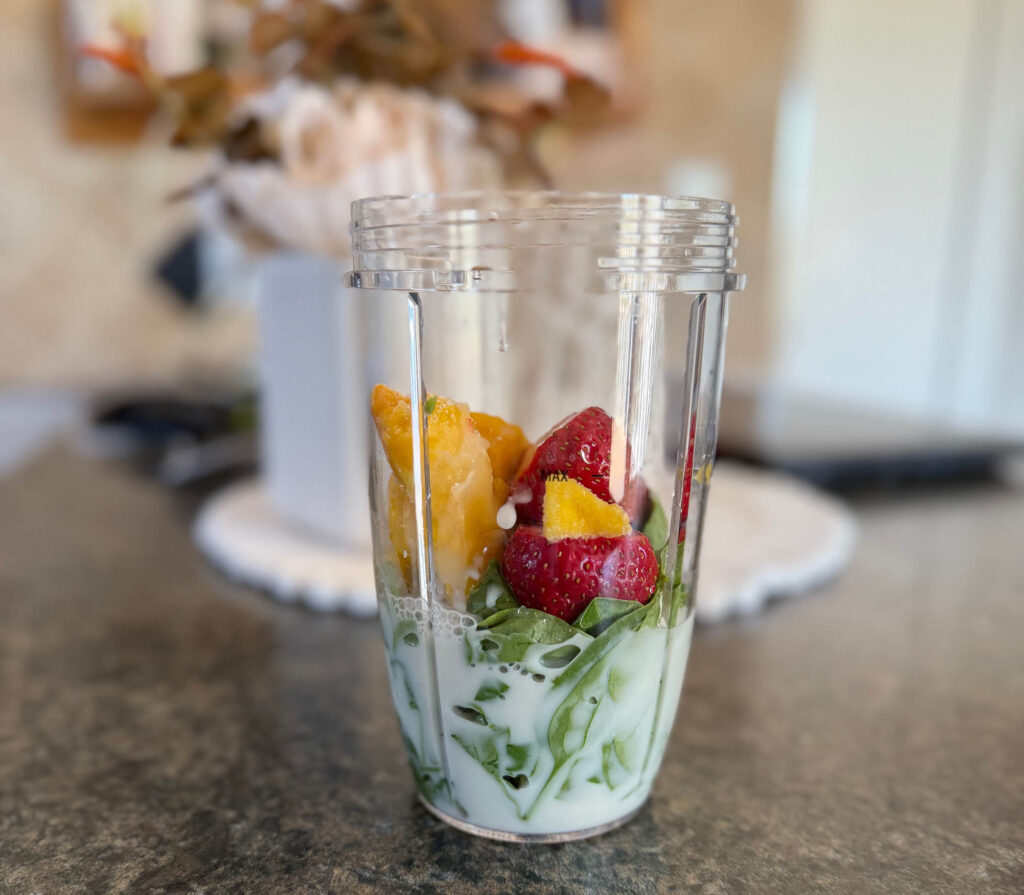Most of us know we should eat more vegetables and fruits, but actually doing it can be tough. Between busy schedules, picky eaters, or just not loving the taste of some veggies, it’s easy to fall short. One easy and tasty way to get more of these important foods into your day is by drinking smoothies.
Smoothies are quick to make, full of nutrients, and if you make them at home, they can be much healthier than store-bought options.
Drink Your Greens: A Simple Guide to Eating More Fruit & Veg with Homemade Smoothies
Most people struggle to eat the 5–7 daily servings of fruit and—especially—vegetables that health experts recommend. Smoothies are an easy fix: you can drink a big portion in minutes, even if you’re busy or not fond of salads. Below is an evidence-based guide you can follow at home.
1. Why bother?
- Better heart health. Large reviews show that every extra serving of produce lowers the risk of heart disease and stroke.
- Weight control. Veggies add filling fiber for very few calories, helping you feel full without overeating.
- Gut and immune support. Plant foods supply prebiotic fiber, vitamins A, C, folate and hundreds of protective plant chemicals (polyphenols).
2. Why make smoothies yourself?
| Homemade | Store-bought (most brands) |
|---|---|
| Whole fruit & veg, all the fibre kept | Often filtered or strained—less fibre |
| You control what goes in | Added sugars, juices, flavourings |
| Fresh or frozen produce = more vitamins | Pasteurised; vitamin C can drop by 25 %+ |
| Costs pennies per glass | 3–5× the price of DIY |
Take-home: a blender and fresh/frozen produce beat a pricey bottle every time.
3. The basic formula
- Pick a base (1 cup): water, unsweetened milk, or 50 % milk + 50 % water.
- Add fruit (1–2 fists): banana for creaminess, or berries/mango/pineapple for flavour.
- Pile on vegetables (2 fists or more): spinach, kale, cucumber, zucchini, carrot, beets—anything mild works.
- Optional extras: a squeeze of lemon/lime, fresh ginger, mint, or cinnamon.
- Protein boost (see next section).
- Blend 30–45 sec until smooth. Sip straight away or chill up to 24 h.
Tip: Frozen spinach, broccoli, or cauliflower florets make a cold, thick shake and stay fresh for months.
4. Add a scoop of quality protein
Adding 20–25 g of protein (about one scoop of whey isolate or a plain pea–rice vegan powder) turns your smoothie into a balanced mini-meal:
- Keeps blood sugar steady. Protein slows digestion so fruit sugars trickle into your bloodstream rather than spiking it.
- Supports muscle & recovery. Important if you exercise or just want to feel satisfied longer.
- Boosts weight-loss efforts. Higher-protein breakfasts and snacks help curb later cravings.
Choose an unsweetened, low-additive powder. If flavour is needed, use a vanilla or chocolate version with <2 g sugar.
5. Evidence-based tips for success
| Tip | Why it matters |
|---|---|
| Follow the 2:1 veggie-to-fruit rule. | More veg = more micronutrients, fewer sugars. |
| Blend, don’t juice. | Blending keeps the fibre that slows sugar absorption. |
| Drink slowly. | Your brain needs ~15 min to register fullness. |
| Rotate greens. | Variety lowers any risk of building up too much oxalate or goitrogens. |
| Log servings. | Apps or a simple tally sheet keep you honest; aim for 4+ veggie fists daily. |
6. Sample recipes (1 large glass)
- Green Starter
- 1 cup water
- 1 ripe banana
- 2 fists baby spinach
- 1 tbsp peanut butter
- 1 scoop whey isolate
- Berry-Beet Booster
- ½ cup unsweetened almond milk + ½ cup water
- 1 cup frozen mixed berries
- ½ small cooked beet or raw grated beet
- 1 fist kale (ribs removed)
- 1 scoop plant protein
- Tropical Veggie Twist
- 1 cup coconut water
- ½ cup frozen pineapple
- ½ cup frozen mango
- 1 fist cucumber chunks
- 1 fist zucchini slices
- 1 tsp grated fresh ginger
- 1 scoop whey isolate
7. Common questions answered
- Will fruit make the smoothie too sugary?
Not if you keep to one banana or a cup of berries and load up the veggies. - Can kids drink these?
Yes. Use milder greens like spinach and skip extra herbs/spices at first. - No blender?
A stick (immersion) blender in a tall jar works. Some gyms/hotels also have blender bottles with a metal whisk ball—soft fruits and powders mix fine.
Bottom line
Homemade smoothies are a fast, tasty way to double or triple your daily vegetables while still enjoying fruit. They’re cheaper and healthier than bottled versions, and adding a scoop of high-quality protein turns them into a complete, blood-sugar-friendly meal or snack.
Grab your blender tonight, throw in whatever greens you have, add a bit of fruit, a scoop of protein, and you’re already one gulp closer to the recommended daily produce goal. Your heart, gut—and taste buds—will thank you.
References (plain-language summaries)
- World Health Organization: 400 g/day fruit & veg target.
- Appleton et al., 2016: Higher produce intake ↔ lower heart disease risk.
- American Dietetic Association: Fibre increases satiety, aids weight control.
- Harvard School of Public Health: Phytochemicals and chronic disease protection.
- Phillips & Van Loon, 2011: Protein supports muscle repair.
- Leidy et al., 2015: High-protein snacks reduce evening snacking.

